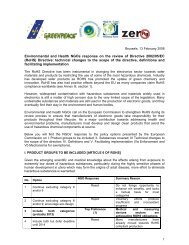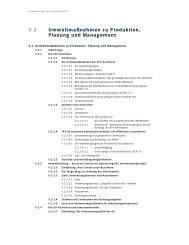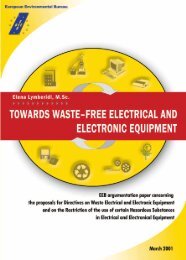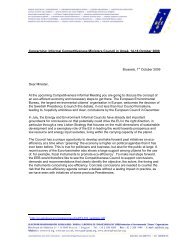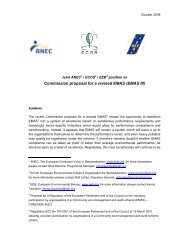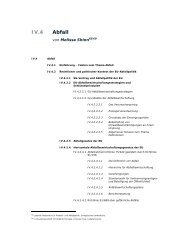Eu Mercury phase out in Measuring and Control Equipment - EEB
Eu Mercury phase out in Measuring and Control Equipment - EEB
Eu Mercury phase out in Measuring and Control Equipment - EEB
You also want an ePaper? Increase the reach of your titles
YUMPU automatically turns print PDFs into web optimized ePapers that Google loves.
REPORT FROM THE CONFERENCE “EU MERCURY PHASE OUT IN MEASURING AND CONTROL EQUIPMENT” Accord<strong>in</strong>g to a 2005 survey of 554 healthcare facilities, conducted by the American HospitalAssociation, 73 % of respondents had removed all mercury sphygmomanometers. Accord<strong>in</strong>g to the Interstate <strong>Mercury</strong> Education <strong>and</strong> Reduction Clear<strong>in</strong>ghouse: one third ofthe US population is covered by mercury state level sphygmomanometer bans orrestrictions. Group Purchas<strong>in</strong>g Organisations(GPOs) represent over $52 billion or 96 % of all contracthealthcare purchases made <strong>in</strong> the U.S. In a 2005 survey of GPOs, three of the five largestUS GPOs had implemented mercury-free purchas<strong>in</strong>g policies that ban items from contractsexcept where a non-mercury alternative is not available. Hospitals <strong>and</strong> hospital systems represent<strong>in</strong>g over 80 medical centres <strong>and</strong> more than 200,000employees have provided HCWH with letters that detail the success of their mercuryelim<strong>in</strong>ation programmes.Kathy Gerwig Vice President of Kaiser Permanente, which is a non profit healthcare provider <strong>in</strong> theUSA with 156,000 employees, said: “<strong>in</strong> the years s<strong>in</strong>ce we made the change to mercury-free(aneroid) devices we have not had any issues with accuracy or other compla<strong>in</strong>ts.”A similar statement was made by Nancy Mulvihill, Vice President of the Covenant Health Systems:“In the more than three years that we have made the changes to aneroid units, <strong>and</strong> digital bloodpressure units, we have not had any issues with accuracy …I hope … that you will be conv<strong>in</strong>ced aswe were, that it is <strong>in</strong> the best <strong>in</strong>terest of all concerned to elim<strong>in</strong>ate mercury sphygmomanometers”.Mary Ellen Leciejewski of Catholic Healthcare West, a not-for-profit healthcare system composedof 41 hospitals, 68 cl<strong>in</strong>ics <strong>and</strong> 9 trauma centers stated: “I am writ<strong>in</strong>g to share our successfulexperience <strong>in</strong> the elim<strong>in</strong>ation of mercury blood pressure devices…As our experience hasdemonstrated, cost effective viable alternatives to mercury blood pressure measurement areavailable <strong>in</strong> the marketplace.”After the success <strong>in</strong> the USA, HCWH started to focus on the rest of the world. Now HCWH islook<strong>in</strong>g at how to get mercury <strong>out</strong> of healthcare globally. Part of the strategy is to run workshops<strong>and</strong> work with develop<strong>in</strong>g countries on pilot projects for substitut<strong>in</strong>g mercury devices. As a result ofthat HCWH has policy <strong>in</strong>itiatives on several levels. There are national policy models like <strong>in</strong> thePhilipp<strong>in</strong>es. The Philipp<strong>in</strong>es had an adm<strong>in</strong>istrative order to <strong>phase</strong> <strong>out</strong> mercury from the healthcaresector across the country over two years <strong>and</strong> this <strong>in</strong>cludes sphygmomanometers.HCWH also had a big success <strong>in</strong> Argent<strong>in</strong>a where the M<strong>in</strong>istry of Health issued a Resolution <strong>in</strong>February 2009 bann<strong>in</strong>g the purchase of all new mercury thermometers <strong>and</strong> sphygmomanometers <strong>in</strong>the healthcare system. On the municipal level there is the example of Buenos Aires, which hasimplemented a policy to <strong>phase</strong> <strong>out</strong> mercury from 33 public hospitals <strong>and</strong> 38 healthcare centres– thelargest public health system <strong>in</strong> Argent<strong>in</strong>a. The policy is 80 percent implemented. This is a model forlarge cities <strong>in</strong> develop<strong>in</strong>g countries <strong>and</strong> actually served as a sample for the national law <strong>in</strong> Argent<strong>in</strong>aon bann<strong>in</strong>g mercury. Buenos Aires is a success story <strong>and</strong> now the country is ready to go forward<strong>and</strong> to follow the example of the city. Also Delhi (India) has developed a city-wide policy. Elevengovernment hospitals have either <strong>phase</strong>d-<strong>out</strong> or are phas<strong>in</strong>g <strong>out</strong> mercury thermometers <strong>and</strong> bloodpressure devices from their facilities.For prov<strong>in</strong>cial <strong>and</strong> state level policies there is the example of Kwa Zulu Natal <strong>in</strong> S<strong>out</strong>h Africa. Hereaga<strong>in</strong> it is the policy replac<strong>in</strong>g sphygmomanometers <strong>and</strong> thermometers.In <strong>Eu</strong>rope there are many hospitals that have <strong>phase</strong>d <strong>out</strong> mercury sphygmomanometers. Countriessuch as Sweden, Denmark <strong>and</strong> the Netherl<strong>and</strong>s, have elim<strong>in</strong>ated mercury from healthcare almostentirely. <strong>Eu</strong>rope has a mercury export ban. The goal should be to <strong>phase</strong> <strong>out</strong> mercury40



